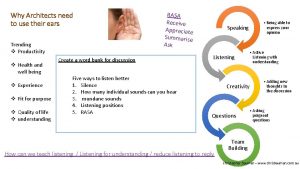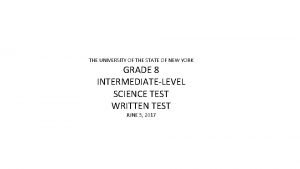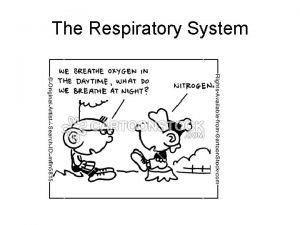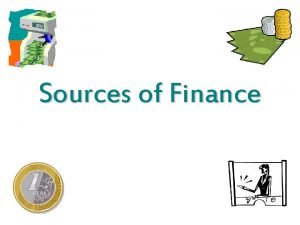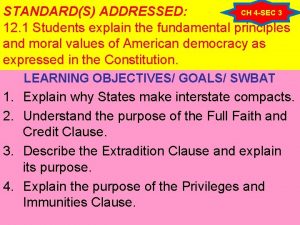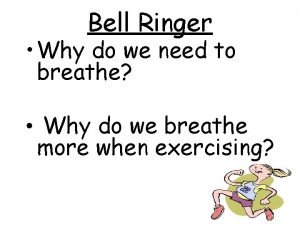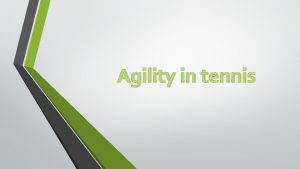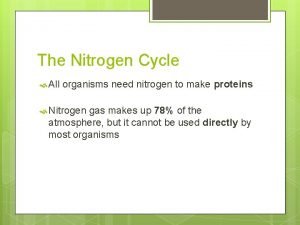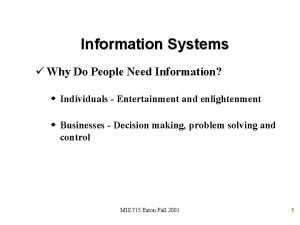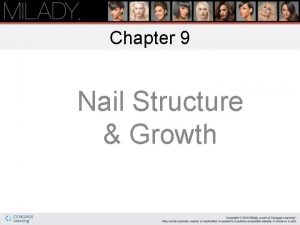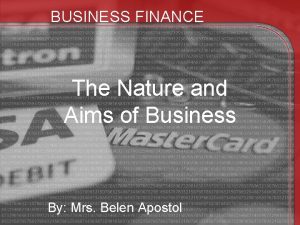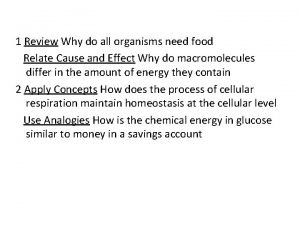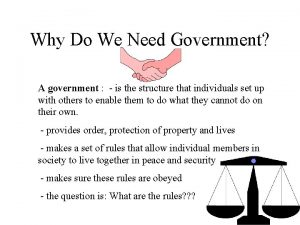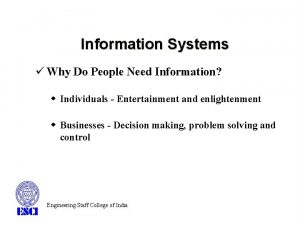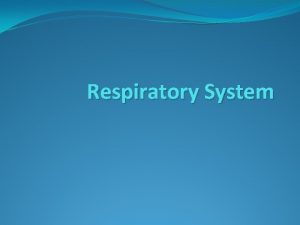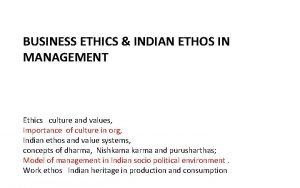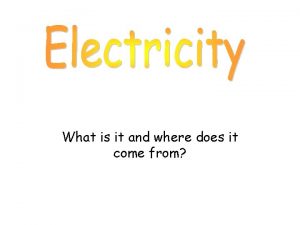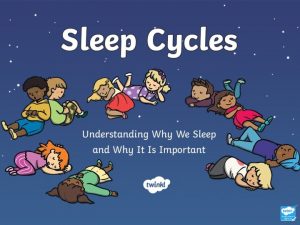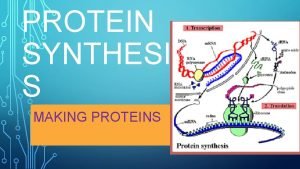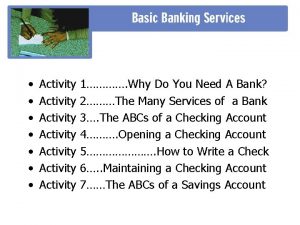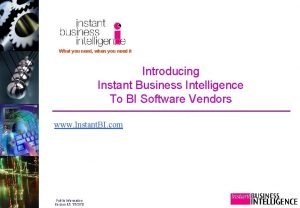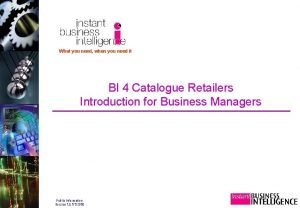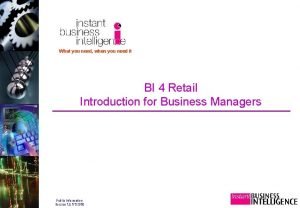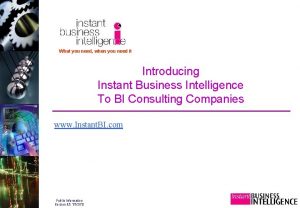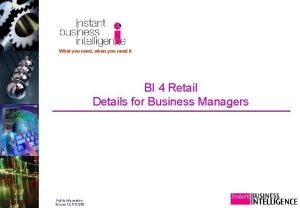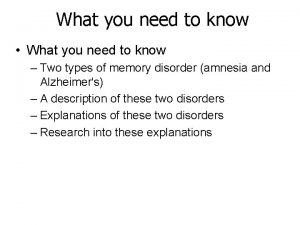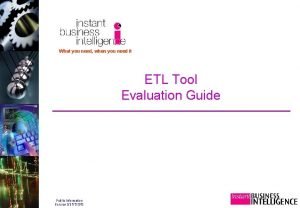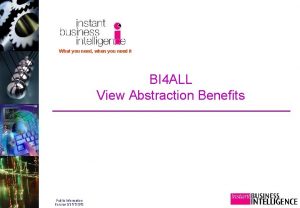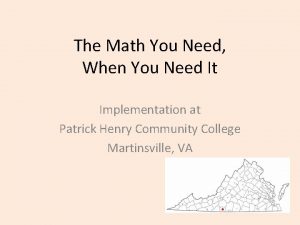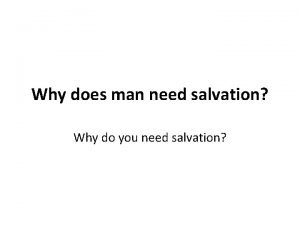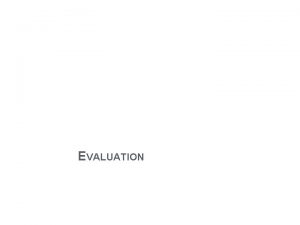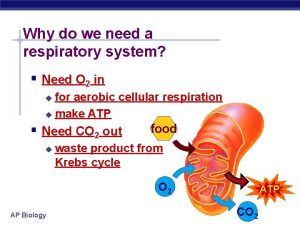Activity Activity 1 Why Do You Need A


































- Slides: 34

• • Activity Activity 1…………. Why Do You Need A Bank? 2………The Many Services of a Bank 3…. The ABCs of a Checking Account 4………. Opening a Checking Account 5…………………. How to Write a Check 6…. . Maintaining a Checking Account 7……The ABCs of a Savings Account

ACTIVITY 1 Why Do You Need a Bank? Overview • Purposes of banks • The differences between banks and credit unions • Safety of financial institutions • Banks as money management tools • The Earned Income Tax Credit 2 Basic Banking Services - Activity 1

SAFETY OF FINANCIAL INSTITUTIONS COMMERCIAL BANKS 3 CREDIT UNIONS Slide 1 – Safety of Financial Institutions Lesson Reference: Basic Banking Services, Activity 1 – Overhead 3

THE EARNED INCOME TAX CREDIT The Earned Income Tax Credit (EITC) is a federal income tax credit for lowincome workers. The credit reduces the amount of tax an individual owes, and may be returned to the taxpayer in the form of a refund. Some states offer additional forms of EITC. Eligible workers must have an annual income and investment income that falls below a certain level. In tax year 2005, for example, if you are married, have two or more children, and are filing your taxes jointly, your combined annual income must not exceed $37, 263. You must have a Social Security Number to receive the EITC. In tax year 2005, a family with two or more children could receive up to a $4, 400 refund through the EITC. * 4 Slide 2 – EITC Lesson Reference: Basic Banking Services, Activity 1 – Handout 2

ACTIVITY 2 The Many Services of a Bank Overview • • 5 Financial services provided by a bank Bank employees Services that might be of personal benefit The impact of state and federal regulations upon the security of a bank Basic Banking Services - Activity 2

REMITTANCE OPTIONS TO SEND AND RECEIVE MONEY 1. 2. 3. 4. 5. 6. 7. 6 Money Transfer Organizations Bank Transfers Hand Delivery Mail Hawala Post Offices Stored Value Cards Slide 1 – Remittance Options Lesson Reference: Basic Banking Services, Activity 2 - Overhead 1

BANK OCCUPATIONS • • • 7 Tellers Platform Bankers Mortgage Lenders Operations Manager Branch Manager Slide 2 – Bank Occupations Lesson Reference: Basic Banking Services, Activity 2 – Overhead 2

ELECTRONIC BANK SERVICES Online banking is the fastest growing Internet activity in the U. S. Types of Services • Bank Cards • Automated Services Protect Your Passwords! 8 Slide 3 - Electronic Bank Services Lesson Reference: Basic Banking Services, Activity 2 – Overhead 3

BANK CARD TYPES 9 TYPE • Check Cards or ATM/Debit Cards DESCRIPTION • Stored Value Cards • Bank cards with preset, limited value. • Used to pay for goods and services. • Alternative to cash. • Bank cards that allow for the payment of goods and services to be subtracted directly from a bank deposit account. • Can be used with merchants that take major credit cards—known as point of sale (POS) transactions. Slide 4 - Bank Card Types Lesson Reference: Basic Banking Services, Activity 2 – Overhead 4

ELECTRONIC BANK SERVICES • • • 10 Direct Deposit Transfers between Accounts Transfers to a Third Party Online Banking Bank by Phone ATM Slide 5 – Electronic Bank Services Lesson Reference: Basic Banking Services, Activity 2 – Handout 3

REGULATION OF ELECTRONIC BANKING SERVICES Electronic Fund Transfer Act Protects consumers using any type of electronic banking from loss and protects their privacy. Banks must: • Offer consumers a record or receipt for all computer transactions. • Investigate errors and report to consumer within ten days of error notification. Customers are responsible to report any errors. 11 Slide 6 - Regulation of Electronic Banking Lesson Reference: Basic Banking Services, Activity 2 – Overhead 5

ACTIVITY 3 The ABCs of a Checking Account Overview • Purposes of a checking account • Shopping for and comparing checking accounts 12 Basic Banking Services - Activity 3

CHECKING ACCOUNT TERMS • Bank Statement • Cancelled Check • Check Register/Ledger • Endorsement • Fee • Interest • Minimum Balance 13 • Outstanding Transactions • Overdraft Protection • Payee • Reconciling a Bank Statement • Transaction Limits Slide 1 - Checking Account Terms Lesson Reference: Basic Banking Services, Activity 3 – Handout 1

SHOPPING AROUND (THINGS TO ASK ABOUT WHEN OPENING A CHECKING ACCOUNT) 14 SERVICES Location of bank Location of ATMs Banking hours Minimum balance required Minimum transactions or limits Interest-bearing accounts? Other COSTS Non-primary bank ATM transactions In-branch transaction fees Per-check fees Other checking fees Overdraft protection Printing of checks Slide 2 - Shopping Around Lesson Reference: Basic Banking Services, Activity 3 - Handout 2

ACTIVITY 4 Opening a Checking Account Overview • • • 15 Checking Account Application Process The Application Acceptable Forms of ID The Signature Authorization Card The PATRIOT Act Basic Banking Services - Activity 4

OPENING A CHECKING ACCOUNT 16 Slide 1 – Opening a Checking Account Lesson Reference: Basic Banking Services, Activity 4 – Handout 1

COMMONLY ACCEPTED FORMS OF ID Primary ID* • Photo Driver’s License issued within the U. S. or Canada • State Non-Driver Photo ID • Photo Learner’s Permit • Government Photo ID • U. S. Passport • Non-U. S. Passport • Resident Registration Card • Naturalization Certificate • Employee Photo ID (from a recognizable employer) • Photo Trade License (barber, plumber, electrician, etc. ) • Student Photo ID (college/trade school) • Medicare Card (must be 65 or older) • Mexican Consular ID (Matricula Consular) * Financial institutions' ID requirements may differ; check with the institution first before applying for an account. 17 Slide 2 - Commonly Accepted Forms of ID Lesson Reference: Basic Banking Services, Activity 4 – Handout 2

COMMONLY ACCEPTED FORMS OF ID Secondary ID* • Foreign Driver’s License • Pay Stub • State/Local Gun Permit • Car Registration • Utility Bill (Name and address of individual account should be listed) • Mortgage Statement • Current Bank Statement • Letter of Introduction from Bank, Embassy, or well-known Employer • National Credit Card • Welfare Card • Bank-issued Debit or Check Card • Supplemental Health Insurance Card * Financial institutions' ID requirements may differ; check with the institution first before applying for an account. 18 Slide 3 - Commonly Accepted Forms of ID Lesson Reference: Basic Banking Services, Activity 4 – Handout 2

THE PATRIOT ACT Congress passed the PATRIOT Act in response to the terrorist attacks of September 11, 2001. Financial institutions are now required to collect certain information when a new account is opened. 1. The customer must provide identification that includes name, date of birth, address, and identification number. 2. The institution must maintain a copy of the information used to verify the person’s identity. 3. The institution must determine whether the applicant appears on the lists of known or suspected terrorists or terrorist organizations. 19 Slide 4 – The PATRIOT Act Lesson Reference: Basic Banking Services, Activity 4 – Overhead 1

SIGNATURE AUTHORIZATION CARD 20 Slide 5 – Signature Authorization Card Lesson Reference: Basic Banking Services, Activity 4 – Handout 3

ACTIVITY 5 How to Write a Check 21 Basic Banking Services - Activity 5

WRITING A CHECK 22 Slide 1 - Writing a Check Lesson Reference: Basic Banking Services, Activity 5 – Handout 1

ACTIVITY 6 Maintaining a Checking Account Overview • • • 23 Check 21 Keeping a check register Making a deposit into a checking account Reconciling a bank statement Maintaining a checking account Avoiding Overdrafts Basic Banking Services - Activity 6

CHECK 21 Check 21 is a federal law that helps banks handle more checks electronically and that makes check processing faster and more efficient. Under this law, a check deposited in a bank is typically “delivered” overnight to the paying bank and deducted from the checkwriter’s account on the next business day. Money may be deducted from your checking account almost immediately. 24 Slide 1 – Check 21 Lesson Reference: Basic Banking Services, Activity 6 – Handout 1

KEEPING A CHECK REGISTER 25 Slide 2 - Keeping a Check Register Lesson Reference: Basic Banking Services, Activity 6 – Handout 2

MAKING A DEPOSIT - ENDORSING A CHECK The Back Side of a Check Restrictive Endorsement (most secure) Blank Endorsement (least secure) 26 Endorsement to a third party Slide 3 - Making a Deposit - Endorsing a Check Lesson Reference: Basic Banking Services, Activity 6 – Handout 2

MAKING A DEPOSIT COMPLETING A DEPOSIT SLIP 27 Slide 4 - Making a Deposit - Completing a Deposit Slip Lesson Reference: Basic Banking Services, Activity 6 – Handout 2

RECONCILING A BANK STATEMENT 28 Slide 5 - Reconciling a Bank Statement Lesson Reference: Basic Banking Services, Activity 6 – Handout 2

OVERDRAFTS AND BOUNCED CHECKS Overdrafts and bounced checks occur when you complete a financial transaction (e. g. , write a check) for more than what is available in the account. Your financial institution may pay the amount and charge you a fee, known as an “overdraft fee” or a “nonsufficient funds fee. ” Tip: Avoid overdraft or non-sufficient funds fees by making a habit of monitoring the balance in your checking account. 29 Slide 6 – Overdrafts and Bounced Checks Lesson Reference: Basic Banking Services, Activity 6 – Overhead 1

ACTIVITY 7 The ABCs of a Savings Account Overview • • 30 Purpose of a savings account Shopping for a savings account Applying for a savings account Monthly bank statement checkup Basic Banking Services - Activity 7

REASONS TO SAVE • Emergencies • Future Purchases • Future Investments 31 Slide 1 - Reasons to Save Lesson Reference: Basic Banking Services, Activity 7 – Overhead 1

SHOPPING FOR A SAVINGS ACCOUNT Factors to consider: • • • 32 Safety Risk Liquidity Minimum Account Balance Requirements Fees and Service Charges Interest Rate Returns (Earnings) Automatic Transfer Direct Deposit Slide 2 - Shopping for a Savings Account Lesson Reference: Basic Banking Services, Activity 7 – Overhead 2

OPENING A SAVINGS ACCOUNT 33 Slide 3 – Opening a Savings Account Lesson Reference: Basic Banking Services, Activity 7 – Overhead 3

BANK STATEMENT 34 Slide 4 – Bank Statement Lesson Reference: Basic Banking Services, Activity 7 – Overhead 4
 Andreas carlsson bye bye bye
Andreas carlsson bye bye bye Why do you cry willy tongue twister
Why do you cry willy tongue twister Wish you a lot of strength
Wish you a lot of strength You control your destiny you don't need magic to do it
You control your destiny you don't need magic to do it Don't ask why why why
Don't ask why why why Why architects need to use their ears
Why architects need to use their ears Image by sir john gilbert printed in 1873
Image by sir john gilbert printed in 1873 Which principle
Which principle Why do we need to breathe
Why do we need to breathe Sources of finance
Sources of finance Why we need computer
Why we need computer Lamillae
Lamillae Why do we need arrays?
Why do we need arrays? Chapter 4 section 3 interstate relations answer key
Chapter 4 section 3 interstate relations answer key Do cells need energy
Do cells need energy Why do we need to breathe
Why do we need to breathe Agility in table tennis
Agility in table tennis We need to water
We need to water All organisms need nitrogen to
All organisms need nitrogen to Why do people need information
Why do people need information Why do we need cracking
Why do we need cracking What are the nine parts of the nail unit
What are the nine parts of the nail unit Why do we need to study the nature and aims of business?
Why do we need to study the nature and aims of business? Why do all organisms need food
Why do all organisms need food Why do we need a government
Why do we need a government Why do animals need a nervous system
Why do animals need a nervous system Which is the type of motion of size separation?
Which is the type of motion of size separation? Why do people need information
Why do people need information Couter
Couter Plants
Plants Components of indian ethos
Components of indian ethos Why we need electricity
Why we need electricity Why we need sleep
Why we need sleep Why do we need cells
Why do we need cells Why do we need food
Why do we need food





